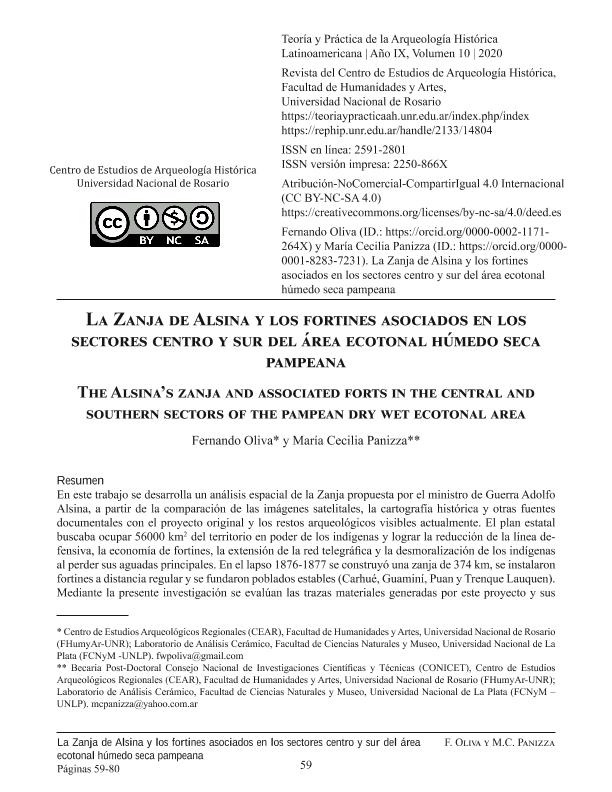Artículo
En este trabajo se desarrolla un análisis espacial de la Zanja propuesta por el ministro de Guerra Adolfo Alsina, a partir de la comparación de las imágenes satelitales, la cartografía histórica y otras fuentes documentales con el proyecto original y los restos arqueológicos visibles actualmente. El plan estatal buscaba ocupar 56000 km2 del territorio en poder de los indígenas y lograr la reducción de la línea defensiva, la economía de fortines, la extensión de la red telegráfica y la desmoralización de los indígenas al perder sus aguadas principales. En el lapso 1876-1877 se construyó una zanja de 374 km, se instalaron fortines a distancia regular y se fundaron poblados estables (Carhué, Guaminí, Puan y Trenque Lauquen). Mediante la presente investigación se evalúan las trazas materiales generadas por este proyecto y sus características en el área de estudio, considerando como unidades operativas la zanja y paredón junto con los fortines asociados. In this work a spatial analysis of the Zanja proposed by the Minister of War Adolfo Alsina is developed, based on the comparison of satellite images, historical cartography and other documentary sources with the original project and the remains of the archaeological sites currently visible. The state plan sought to occupy 56000 km2 of the territory held by the indigenous people and achieve the reduction of the defen-sive line, the forts economy, the extension of the telegraph network and the demoralization of the indige-nous by losing their main water. In the period 1876-1877 a 374 km ditch was built, forts were installed at regular distance and stable villages were founded (Carhué, Guaminí, Puan and Trenque Lauquen). This research evaluates the material traces generated by this project and their characteristics in the study area are evaluated, considering as operational units the trench and walling together with the associated forts.
La Zanja de Alsina y los fortines asociados en los sectores centro y sur del área ecotonal húmedo seca pampeana
Título:
The Alsina’s zanja and associated forts in the central and southern sectors of the pampean dry wet ecotonal area
Fecha de publicación:
22/09/2020
Editorial:
Centro de Estudios de Arqueología Histórica
Revista:
Teoría y Práctica de la Arqueología Histórica Latinoamericana
ISSN:
2250-866X
e-ISSN:
2591-2801
Idioma:
Español
Tipo de recurso:
Artículo publicado
Clasificación temática:
Resumen
Palabras clave:
FRONTERA
,
FORTINES
,
SIGLO XIX
,
ECOTONO
,
ZANJA
Archivos asociados
Licencia
Identificadores
Colecciones
Articulos(CCT - ROSARIO)
Articulos de CTRO.CIENTIFICO TECNOL.CONICET - ROSARIO
Articulos de CTRO.CIENTIFICO TECNOL.CONICET - ROSARIO
Citación
Oliva, Fernando; Panizza, María Cecilia; La Zanja de Alsina y los fortines asociados en los sectores centro y sur del área ecotonal húmedo seca pampeana; Centro de Estudios de Arqueología Histórica; Teoría y Práctica de la Arqueología Histórica Latinoamericana; 10; 22-9-2020; 59-80
Compartir
Altmétricas




